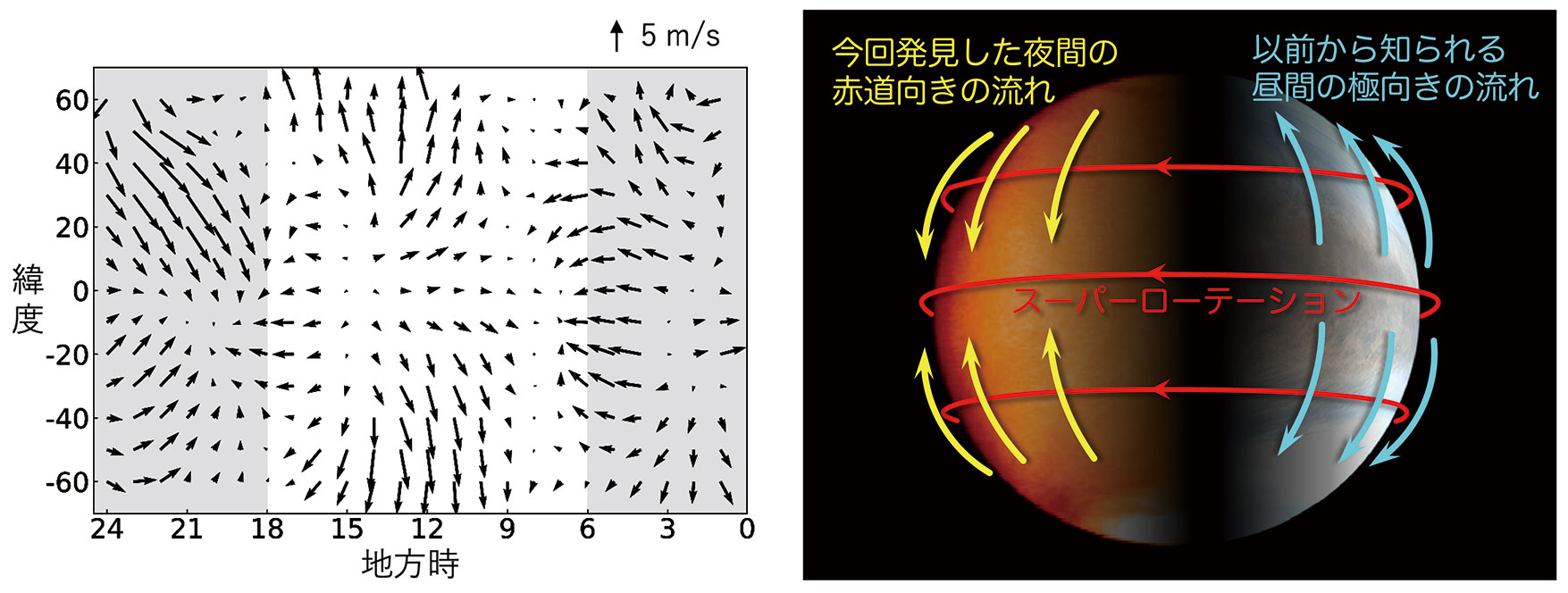Disclaimer: machine translated by DeepL which may contain errors.
Watching the Night Winds of Venus
Kiichi Fukutani (Department of Earth and Planetary Science, Master's Program (at the time of research)) |
Tsuyoshi Imamura (Professor, Graduate School of Frontier Sciences / Department of Earth and Planetary Science) |


Venus is surrounded by a dense carbon dioxide atmosphere, and its surface is scorching hot at 460°C due to the greenhouse effect. Sulfuric acid clouds float seamlessly at an altitude of around 60 km, and "super-rotating" wind storms of up to 100 m/s blow across Venus at 60 times the speed of the planet's slow rotation. The fact that Venus, which is about the same size as the Earth, has such an unusual environment raises the question of how the environment of the Earth and other planets is created. The super-rotation of clouds and atmosphere covering the entire planet is now known to exist not only on Venus, but also on Titan, a moon of Saturn, and on other planets outside our solar system. Venus, which is located right next to the Earth and can be studied in detail, has become a reference for understanding planets with common atmospheric phenomena.
The motion of the Venusian atmosphere has been mainly inferred from the movement of clouds illuminated by sunlight. This, of course, does not tell us about the nocturnal winds. Of course, super-rotation also occurs at night, but what we want to know is the atmospheric phenomena that occur in a super-rotating atmosphere. For example, at cloud tops during the daytime, there is a flow of about 10 m/s from the equator to the poles. When this poleward flow was first discovered about 40 years ago, it was interpreted as capturing the Hadley circulation, in which the atmosphere heated by solar radiation at the equator rises and flows toward high latitudes. In recent years, however, it has also been interpreted as capturing a portion of "thermal tidal waves," which are fluid waves excited by solar heating, and the contribution of each has not been understood. The Hadley circulation is an averaged flow of all north-south winds during the day and night, and thermal tidal waves are waves that cause differences in winds during the day and night. The former is responsible for the circulation of heat and matter, while the latter transports momentum and can act to maintain superrotation, and thus have remained the main interest of Venus meteorology. To elucidate these phenomena, winds must be measured day and night, but this has not been possible until now.
In this study, we successfully visualized the movement of clouds in both day and night by taking infrared images of cloud emissions with the onboard infrared camera of the AKATSUKI spacecraft. As a result, it was found that during the night, the flow from the poles toward the equator is opposite to that during the day, and that the north-south circulation is almost zero on average throughout the day and night. This can be interpreted as the poleward flow of the Hadley circulation being higher than the cloud tops and the equatorward flow being lower than the cloud tops, resulting in weak north-south flow at the cloud tops at intermediate altitudes. The differences in mean wind speeds at different times of the day revealed the structure of thermal tidal waves, which are responsible for the maintenance of the super-rotation.
The discovery of the nighttime wind, which has been a mystery for 40 years, has greatly advanced our understanding of the Hadley circulation and super-rotation, the two major processes of atmospheric circulation. The dynamical response of the atmosphere to solar heating in the cloud layer, as revealed in this study, is expected to play an important role in the super-rotation of exoplanets orbiting near the central star, and is an important theme for future research.
This study was published in Nature 595, 511 (2021) by K. Fukuya et al.
(Press release on July 22, 2021)
Published in the November 2021 issue of Faculty of Science News
Communicating to Faculty Research Students >



